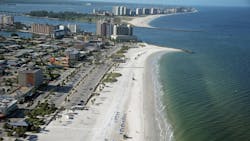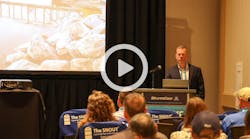Pinellas County Commission approves $125.7 million beach nourishment project
Pinellas County, Florida will undertake a one-time emergency beach nourishment project that will partially restore protection of coastal communities and infrastructure by replacing a significant amount of the sand lost to last year’s hurricanes, the County Commission decided on June 17, 2025.
After years of unsuccessful attempts to resolve policy disagreements with the US Army Corps of Engineers, the County Commission approved Pinellas County Public Works effort to design, permit and complete this project using County funds.
The $125.7 million project will be funded by hotel bed tax dollars, paid for by visitors, and state grants. Previous projects benefitted from a 65% federal cost-share through the U.S. Army Corps of Engineers (USACE), but without easements from all property owners, the County is no longer eligible for federal funding. The County and municipal partners have conducted extensive public outreach concerning the importance of acquiring easements to provide for a contiguous nourishment project, which would offer the greatest protection.
County Public Works staff have worked tirelessly to earn approval for emergency construction permits from State and Federal environmental regulators since hurricanes damaged the beaches last year. This county-funded project will put sand on Sand Key (Clearwater Beach to Belleair Beach and Indian Rocks Beach to North Redington Beach), Treasure Island and Upham Beach starting later this year.
“Our beaches are our most treasured asset, and we’re working with our beach communities to protect them,” Commission Chair Brian Scott said in a press release. “A healthy beach offers protection to property and infrastructure against storm surge, and it’s vital to tourism. But our residents should know we won’t be able to continue to do these projects without the full buy-in of our coastal communities.”
County staff created a temporary construction easement that was less restrictive than the language required by the Army Corps to complete this project, but many residents along the beach were still unwilling to sign the modified easement. As a result, the project will leave gaps where sand will not be placed or will be placed only seaward of the Erosion Control Line (ECL), particularly on Sand Key, where property owners could not be located or chose not to sign construction easements. Easements are still being accepted, and additional properties may still be added to the project, depending on the stage of surveying. If construction has already occurred past a property owner who has not signed, then it will be too late for that property owner to sign an easement to get sand for this upcoming project. Properties without easements will see a higher beach from the Erosion Control Line west into the gulf. In many instances, this will leave a lower elevation in the area for which easements were not provided.
Beach nourishment is expensive and is required at least every six years or more frequently due to storms, but it is necessary to protect coastal infrastructure. While the County was able to draw funding from the tourist development tax for this project, projects of this magnitude will require other funding sources in the future. County staff and Commissioners will continue to work with the USACE and local residents to find an agreeable solution, which will likely need to include some form of easement agreement with property owners.


